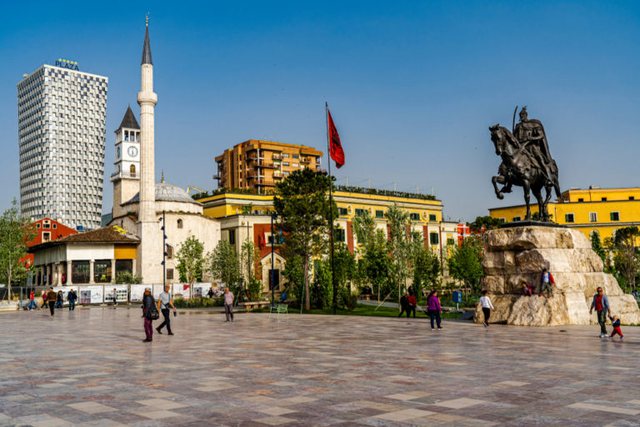
 Flash News
Flash News
The life expectancy of Albanians in 70 years increased by 42%, the pandemic turned it into a decline

Albanians in the 1950s lived an average of only 54.4 years according to official INSTAT data, while from that time until 2020, life expectancy increased by 42%.
An Albanian in 2020 lived an average of 77.3 years with a decrease from 2018 by about 3.3 months as a result of the increase in deaths at a young age from the coronavirus pandemic.
Historical data on life expectancy in the last 70 years, show whether the greatest improvement occurred in the two decades of 1950-1970, this indicator increased by 18 years or 33%.
From 54.4 years in 1950 the average life expectancy in 1970 reached 72.3 years.
Since then the life expectancy index in our country has grown at low rates. In the first year of transition the life expectancy in the country was 75.4 years and in 2020 it is estimated at 77.3 years with an improvement increasing by about two years.
In 2020, life expectancy at birth in Albania was 75.2 years for men and 79.6 years for women. This means that women are expected to live about 4 years longer than men.
The population in Albania has changed over the last 30 years. This is especially due to changes in the economic system, moving from a centralized economy to an open market system which has had its effect on births, deaths, migration, and certainly has an impact on the future of the population. Albanian.
Population and life expectancy statistics are very important for other planning. It is important to know how many people currently live in the country and how many there will be in the future, so that better decisions can be made regarding the construction of schools, hospitals and roads. It is also important to know how old the population is and will be in the coming years in order to plan, for example pensions or health care.
On January 1, 2021, the population of Albania is 2.83 million inhabitants and compared to 2011 has decreased by 2.7%. The downward trend continues to be present from previous years. This can be a problem because it can affect economic growth, which depends on the level of consumption or investment. If the population shrinks, then there will be less demand for consumption and investment that may be reflected as an economic downturn.
During the period 2011-2020, the number of births per year has decreased significantly, from about 34 thousand in 2011, to about 28 thousand in 2020, while the number of deaths per year has remained between 20 thousand and 22 thousand for the period 2011-2019, but has increased to about 28 thousand deaths in 2020 affected by the effects of the Covid-19 pandemic.
Also the synthetic fertility index has dropped from 2011 when it was 1.65 children per woman, to 1.34 in 2020.
The decline in fertility is reflected in population numbers in the coming decades and have an impact, not only on population decline, but more on the effects derived from those factors, which may be social or economic, such as purchasing power decline , increasing the rate of age dependence, putting at risk the pension scheme, etc./ Monitor
Latest news




Media: Iran tried to shoot down Trump's plane during the election campaign
2025-06-16 22:04:15
Netanyahu: Eliminating Khamenei would end the conflict with Iran
2025-06-16 21:47:13
Lala: If the Supreme Court acquits Veliaj, a precedent will be created
2025-06-16 21:34:12

Laura Fazliu wins bronze medal at the World Judo Championships
2025-06-16 21:13:32

Car falls off bridge on Saranda-Delvina road, driver injured
2025-06-16 20:58:56
Tourist from Slovakia drowns near the Rock of Kavaja
2025-06-16 20:33:42

Cases of residential burglaries increase significantly during the summer
2025-06-16 20:19:28
Can Trump convince Netanyahu to stop attacking Iran?
2025-06-16 20:17:52
UN financial crisis puts aid for refugees at risk
2025-06-16 19:59:17


Tirana/ 253 complaints for road violations in just one week
2025-06-16 19:24:59


More and more armed drones over the Balkans and no one is watching them
2025-06-16 18:41:28
Korça/ Car goes off the road, woman and two children end up in hospital
2025-06-16 18:25:01
Video/ Iran's state television attacked 'live'
2025-06-16 18:06:21



KPA upholds dismissal of Vlora prosecutor
2025-06-16 17:16:43
The CEC begins the vote recount for four districts tomorrow
2025-06-16 17:08:19

Albanian Railways cuts 47 jobs, maintenance workers affected
2025-06-16 16:43:32
Foods to avoid after 40 for your health
2025-06-16 16:28:08
Albania stands by Israel: Iran must stop nuclear activity
2025-06-16 16:09:08
Two foreign citizens arrested in Dhërmi for selling narcotics
2025-06-16 16:07:54

Transporting illegal immigrants, 24-year-old arrested in Saranda
2025-06-16 15:42:05

NAME/ Elderly man found dead inside a cave in Lezha
2025-06-16 15:15:08


Britain appoints first woman to head intelligence service
2025-06-16 14:49:36


"Passive majority"/ Tabaku: SP has no political will to advance integration!
2025-06-16 14:12:34


Bardhi clashes with Spiropali: Close the Parliament to have lunch in Greece
2025-06-16 13:34:02

Accused of murder, Europol searching for Albanian criminal (NAME)
2025-06-16 13:06:17





"Karma finds its way", to whom is Veliaj's coded message from prison addressed?
2025-06-16 11:59:34
Tragic in Italy! Train hits and kills 19-year-old Italian-Albanian
2025-06-16 11:50:50
Map of towers: How the government is brutally rewriting Tirana
2025-06-16 11:37:09


Earthquake hits northern Macedonia, tremors felt in Albania
2025-06-16 11:00:48
Spahia: Two mandates in Shkodra were stolen from the DP
2025-06-16 10:31:58
"Partizani" file/ Berisha does not appear in SPAK for health reasons
2025-06-16 10:26:43

Belgian tourist injured in Gjipe, boat driver arrested
2025-06-16 10:01:03
NAME/ Drug dealer arrested in Vlora
2025-06-16 09:47:10



Attacks on Iran/DW: German policy in the Middle East under pressure!
2025-06-16 09:15:05
Von der Leyen: Iran must not have nuclear weapons
2025-06-16 09:06:17


Labor market alarm, Albanian workers' skills are 37% of those in the EU
2025-06-16 08:34:47
The Assembly meets in plenary session today, what is expected to be discussed
2025-06-16 08:25:30
35-year-old man shoots himself with a gun in Vlora, sent to 'Trauma'
2025-06-16 08:11:58
Mot i kthjellët në të gjithë vendin, ja parashikimi për këtë të hënë
2025-06-16 07:57:23
Posta e mëngjesit/ Me 2 rreshta: Çfarë pati rëndësi dje në Shqipëri
2025-06-16 07:44:49

Trump vetoes Israeli plan to assassinate Iran's supreme leader
2025-06-15 21:38:01
Vote recount in Tirana, Këlliçi: We want Alimehmet's mandate
2025-06-15 21:17:41
Erdogan calls Trump: We are ready to mediate for Iran
2025-06-15 20:55:34

Netanyahu says he attacked Iran to prevent 'nuclear holocaust'
2025-06-15 20:02:04
Migrant agreements: What benefits Kosovo and why are they criticized?
2025-06-15 19:43:08
Gjirokastër/ Fire burns three hectares of grass near the Kardhiqi Bridge
2025-06-15 19:22:34

Gattuso appointed new Italy national team coach
2025-06-15 18:34:17
Over 400 people have been killed so far in Israeli attacks on Iran
2025-06-15 18:15:47
Trump warns of return to Kosovo-Serbia issue: Biden damaged it
2025-06-15 17:46:52
Bylykbashi: Current electoral system is toxic
2025-06-15 17:25:20
Trump vows for Iran-Israel deal, mentions Kosovo case with Serbia
2025-06-15 16:59:02
German tourist injured on Gjipesa beach, hit by a dinghy's propeller
2025-06-15 16:40:31

Iran attacks Israel with ballistic missiles
2025-06-15 15:48:49
Fecal beach in Durrës, the other side of the tourist miracle
2025-06-15 15:30:57
The attempt to constitute the Assembly in Kosovo fails again
2025-06-15 14:59:10
Ish-presidentit francez Sarkozy i hiqet medalja e Legjionit të Nderit
2025-06-15 14:58:46
Shkodra, with the highest population contraction after the Census
2025-06-15 14:31:47

Caused a fatal accident and left the scene, 35-year-old arrested in Lezha
2025-06-15 13:40:10
